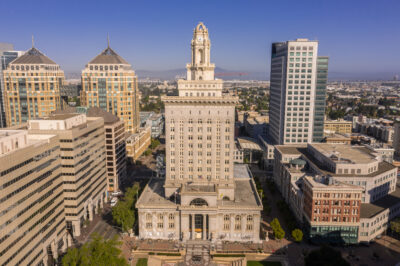NEW REPORT PUTS DAMAGE TOLL FROM OVERDUE MEGA STORM AT $10.4 BILLION
From drought to deluge, California and the Bay Area can expect increasingly dramatic weather swings as the effects of climate change become more pronounced and dangerous. Against that backdrop, the Bay Area Council Economic Institute today (April 20) released a new study estimating the Bay Area would suffer a minimum of $10 billion in economic damages from an extreme storm that many experts believe is overdue—an amount rivaling that of the 1989 Loma Prieta Earthquake.
The damage would be severe along the bay’s thousands of acres of waterfront land, where companies from Facebook to Google employ hundreds of thousands of workers, 355,000 residents have homes and key economic and civic infrastructure is located, including ports, airports, and water, energy, sewage and transportation facilities. The report relies on existing scientific models that envision an “atmospheric river” dumping the equivalent of 10 Mississippi Rivers on the region over 10 days, causing widespread flooding and disruption to road and air travel.
Santa Clara, San Mateo and Marin counties would be hardest hit, with as much as 70 percent of the losses concentrated in low-lying Peninsula and Silicon Valley areas, among the region’s most economically productive corridor. The $10.4 billion estimate includes:
- $5.9 billion in structural damage
- $4.2 billion in damage to building contents
- $128 million in loss of due to electrical facility damages
- $85.7 million in costs due to airport closings or flight delays
- $78 million in costs due to road closures.
Read the full report: Surviving the Storm>>
The costs could be much higher. The estimate does not include the long-term effects of sea level rise, which would magnify the impacts of an extreme storm, nor the economic cost of lost worker productivity.
“Protecting our residents and businesses from natural disasters is a high priority in San Jose,” San Jose Mayor Sam Liccardo said. “Continued regional, state, and federal collaboration to best prepare for Bay flooding from the likes of a 150-year storm is essential to remaining the world’s center of innovation and retaining our economic vitality in the decades ahead.”
“This report highlights the real dangers we face from extreme weather events and climate change in the Bay Area,” San Francisco Mayor Ed Lee said.
“Knowing that we are a coastal city in a region already vulnerable to disaster and that climate change is impacting weather patterns around the globe, we have to take steps to protect ourselves from the inevitable,” Oakland Mayor Libby Schaaf said. “That means heeding the warnings and making smart local and regional investments in our physical and technological infrastructure that build the resiliency we need to safeguard our residents and communities from potential physical and financial devastation.”
The study finds that the scale of the threat is not matched even closely by the level of resources available to fortify the region’s shoreline and flood protection infrastructure, both through manmade structures such as seawalls and levees and natural barriers such as wetlands. At the same time, state, regional and federal funding for flood and storm protection has dropped precipitously.
“Inaction could cost our economy dearly” said Dr. Sean Randolph, one of the report authors and Senior Director of the Bay Area Council Economic Institute. “The $10.4 billion is just a snapshot. The economic consequences of a mega storm, with a magnitude and impact comparable to Hurricane Katrina or Super Storm Sandy, could double when the regional effects of flooding in the Delta are factored in. Much of our existing flood protection infrastructure is aging, and investment in new protective strategies is needed. We cannot afford to be unprotected.”
Further exacerbating the threat is a dangerous lack of public awareness and urgency about the problem, as California understandably focuses its immediate attention on the historic drought. However, the report observes that the Bay Area sits right in the cross hairs of the timeframe when experts forecast the next extreme storm will hit.
“We can’t say we weren’t warned,” said Jim Wunderman, President and CEO of the Bay Area Council.” The Bay Area is past due for a major storm event unlike anything seen since the Gold Rush and potentially as damaging as a major earthquake. Rather than await the inevitable Sandy or Katrina-type event, the Bay Area must proactively reinvest in the levees, sea walls and wetlands needed to defend our homes and businesses. With a little vision, the Bay Area can position itself to become the most climate resilient coastal region on earth.”
The report offers a series of specific and actionable recommendations at the regional, state and federal levels for bolstering the Bay Area’s ability to weather a mega storm and minimize catastrophic economic losses. Among the general recommendations:
- Support the development of cost-effective structural and non-structural strategies, tailored to the region’s variety of local environments, to reduce flood risk.
- Identify new and expand existing local, regional, state and federal funding for flood infrastructure investment.
- Identify and prioritize projects necessary to protect key economic assets such as transport, power, water, wastewater, employment centers, and communications infrastructure.
- Incorporate community resilience to extreme storms into Hazard Mitigation and General Plans.
- Identify ways to leverage new development under regional growth plans to provide local flood protection and reduce economic vulnerability.
- Incorporate climate change predictions, including sea-level rise and changes in rainfall, into flood risk analyses.
- Support development of accurate weather and flood forecasting, particularly for lead time on atmospheric rivers.
In response to the report findings, the Bay Area Council and other key stakeholder groups are launching a regional public information campaign — Our Bay on the Brink — aimed at raising awareness among businesses, elected officials and local community leaders about the potentially devastating consequences and possible solutions. To learn more, visit, www.ourbayonthebrink.com.
The report was created in partnership with California Coastal Conservancy, The Brattle Group, AECOM, Bay Area Flood Protection Agencies, Gordon and Betty Moore Foundation and Gensler.




